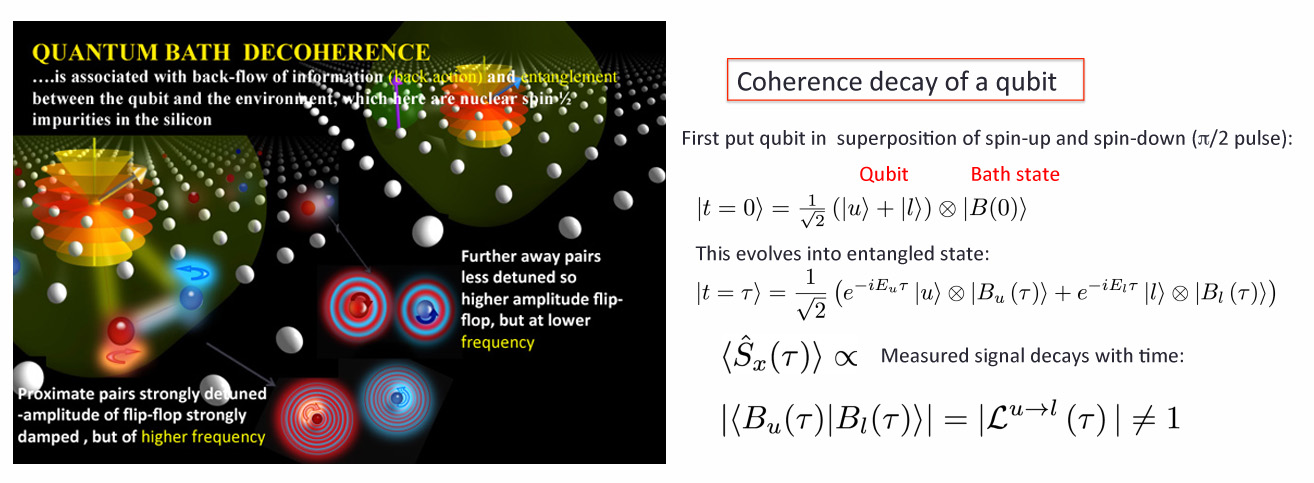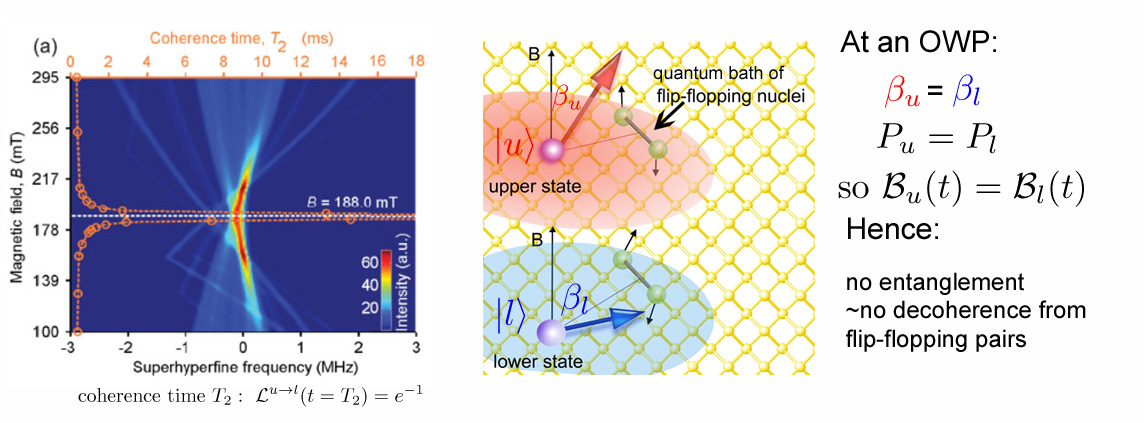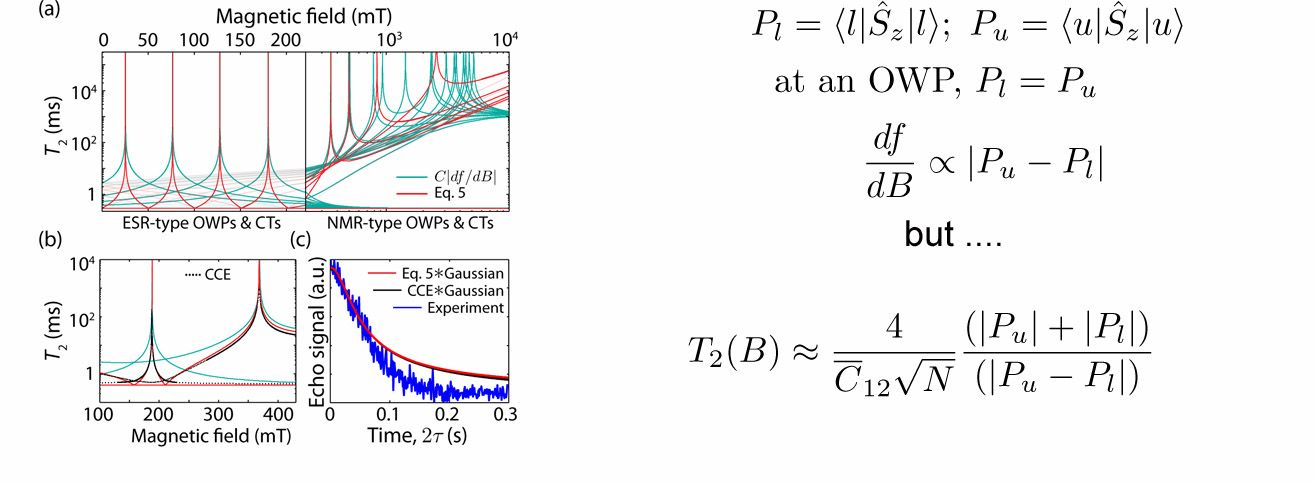Quantum Bath Decoherence
![]()
Quantum Bath Decoherence
Understanding and protecting the coherence of a qubit is crucial for quantum information. Sometimes the source of decoherence are unwanted interactions with other quantum systems: a quantum bath. One notable example is the coherence of electron spins of donors in silicon. Most sites in the silicon are occupied by atoms of the 28Si isotope which have zero nuclear spin; but about 4% of the silicon lattice is occupied by 29Si atoms which have nuclear spin=1/2. Neighbouring 29Si nuclei exchange up/down spin states: they "flip-flop”. One can think of this as a form of magnetic noise -like classical experimental noise. But the flip-flopping is strongly affected by the nearby qubit (it is detuned). Hence for real physical understanding and accurate simulation, one must analyse the joint evolution of central electron spin and the environmental nuclear spins, their mutual entanglement, and the back-action of the qubit on the bath:

Entanglement leads to decoherence of a qubit which is placed in a quantum superposition of up and down states. An electronic qubit entangles with the environmental nuclear spins (the quantum bath) because the time evolution of the bath splits into two parts, correlated with either the upper (u) or lower (l) qubit state. In order to understand the backaction of the qubit on the bath, it is useful to consider separately the average and the difference between the up and the lower Hamiltonians controlling evolution of the bath (average Hamiltonian theory). The difference represents the ability of the quantum bath (the flip-flopping pairs of nuclei) to to provide which-path information (i.e. to discriminate between up and down) the quantum states of the electronic spin -this causes the entanglement. Although each pair of flip-flopping spins only has a small effect, combining the effect of hundreds or thousands of independent (disjoint) pairs reproduces measured coherence decays. An Optimal Working Point (OWP) occurs when -for all pairs- the upper and lower components experience the same Hamiltonian (evolve the same way). In that case qubit-bath entanglement is no longer possible and coherence lifetimes are drastically enhanced.
![]()

In S.J.Balian, M Kunze, M.H.Mohammady, G.W.Morley, W. Witzel, C.W.Kay, T.S.Monteiro PRB 86, 104428 (2012) in the first quantum bath calculation at an OWP of an electron spin for a donor in silicon we showed this orders of magnitude enhancement in coherence times as the OWP is approached. The quantum bath calculations also suggested that the coherence times did not follow well the df/dB relation typical of other systems affected by classical noises.
![]()
Quantum Bath decoherence of OWPs
In S.J.Balian, G. Wolfowicz, J.J.L.Morton and T.S.Monteiro we analysed the decoherence near optimal working points (OWPs). We found that although the df/dB did not give a good fit (except locally over a partial range of B-field), we obtained a formula that fitted the entire range of the echo signal decay both close and far from OWPs (see below). This was obtained by considering the (free induction) decay caused by a single but typical flip-flop pair; this is expected to closely follow the measured echo decay. A correction |P_u|+P_l| was needed to explain the calculated and measured behaviour. One key insight is that the scaling is not simply the ratio between the average and difference Hamiltonians which would be ~(P_u+P_l)/(P_u-P_l). The modulus |P_u|+|P_l| arises because the one-pair decay that emerged was given in terms of the average and difference of the flip-flop frequencies. The global prefactor was obtained heuristically with certain conjectures regarding the properties of the important pairs. Disregarding this actual infinity as it is so narrow (the precise value of B is not easy to hit) and ensemble averaging over nearby values of magnetic field B, the formula gave excellent and detailed agreement with experimental results. This left one problem: the full numerical quantum bath calculation of the spin echo (as opposed to the formula) showed no decoherence at all at the actual OWP: it obtained a coherence T_2 time which is infinite.

![]()
Higher order quantum bath: Cluster Correlation Expansion (CCE)
In S J Balian, Renbao Liu and T.S.Monteiro Phys.Rev.B 91, 245416 (2015) we carried out the first full higher order CCE numerical calculation of the decoherence at OWPs. Previous calculations used only pairs of flip-flopping nuclei, and the pair contribution is completely eliminated at OWPs. Hence this calculation was needed to solve the problem of the infinite T2 obtained in our previous work.
However these disjoint pairs are embedded in larger clusters of 3,4,5 …or more flip-flopping spins
which are close enough to interact with each other. CCE is a theory which allows one to properly consider this hierarchy of clusters without double-counting their contribution.
A calculation with pairs only is termed CCE2; pairs and triplets is CCE3; and so forth.
We provided the first demonstration of the only fully "many-body"
coherence decay mechanism: in other words, the Hahn echo decay at optimal working points is caused almost entirely by environmental flip-flops from 3-body clusters, since the pair contribution is completely eliminated at an optimal working point. All other coherence decays investigated previously for any silicon donors are largely accounted for by pair flip-flops, with higher orders providing only a quantitative correction.
We also investigated dynamical decoupling (DD): instead of a single refocusing
microwave pulse DD involves periodic repetition of these pulses; it is a proven technique
to extend coherence times. We found that DD fully restores the pair contribution; CCE2
describes well DD coherence decays both near or far from optimal working points.

![]()
Donor-donor decoherence (enriched silicon)
In J.E.Lang, S.J. Balian, R.Guichard and T.S.Monteiro arXiv:1509.08326 we had a look at the decoherence of an electronic spin qubit caused by other nearby electronic spin qubits. This mechanism is important for
isotopically enriched samples of silicon where most of the 29Si nuclear spin 1/2 impurities that cause decoherence by flip-flopping have been eliminated, leaving only 28Si which are inert as they have no nuclear spin. Electronic quits can exchange spin states with nearby qubits if
they are in the right quantum state (direct flip-flops); there is also a dephasing mechanism (instantaneous diffusion). We looked at these processes and identified new possible types of OWPs that suppress not only dephasing decoherence but the full
effects of the dipolar interaction between two quits. However, we also found that experimentally measured enhancements at normal OWPs are much larger than expected by the simple theory. This remains unexplained. This preprint remains on the archive, unpublished, as it presents a problem, but offers no conclusive answer. This is left to a future student project!
